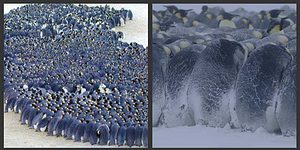
Emperor penguins huddling.
There’s a rather common image that might pop inside someone’s head when thinking of penguins – an entire flock of such animals, standing very close together, keeping themselves warm as they confront extreme sub-zero antarctic temperatures. Don’t be fooled, though. According to the results of a mathematical simulation that modeled penguin huddling, the penguins stick together to keep themselves warm, not the group as a whole, making them egotistical in nature.
Typically, penguins gather around in group as small as tens or as huge as hundreds, rubbing their feathery bodies alongside each other to withstand the cold. While at outside the penguin huddle temperatures may reach extreme sub-zero lows, inside they’re between 20 and 37.5 degrees Celsius (68 to 99.5 degrees Fahrenheit). In extreme weather storms the penguins, though not that small as one might think, can cram as tight as 10 birds in a single square meter.
The inevitable question seems to come – what happens to the penguins that are left on the outskirts of the huddle? Well, when sticking tight together the penguins are never still, on the contrary they’re always on the move. Penguins are constantly shuffle and change positions with one another so that the birds with their backs exposed to the wind find their way inside, while the birds that formerly used to be in the warm interior find themselves on the outside. Wait, doesn’t mean that they’re actually altruistic?
Well, just because almost every penguin gets equally exposed to the same amount of cold doesn’t necessarily mean they’re acting on the benefit of the group of as a whole first thing in mind. Seeking to find whether any penguin gets left out in the cold during a huddle, three applied mathematicians at the University of California, Merced, constructed a mathematical model of penguin huddling.
In order to pack the penguin huddle as tightly as possible, the mathematicians envisioned the penguins on a grid of hexagons, since penguins seem to arrange themselves roughly in the same manner in reality as well. Also, as far as model assumptions go, the mathematicians considered all the penguins in the huddle of uniform shape and size. Concerning the wind, they considered that it flowed around the huddle differently depending on its overall shape.
In order to make the penguins shuffle, they calculated the rate at which each computerized penguin was losing body heat and instructed the coldest penguin to shuffle around the outside of the huddle until it found the warmest spot it could stand in, then started over with the new coldest penguin.
Over time, the model huddle tended to take on the shape of a flat-sided oval and travel slowly downwind. When the flock’s heat loss was computed, the scientists found that overall each penguin lost more or less the same amount of body heat. Where’s the catch then? Well keep in mind that the penguins were programmed to maximize their own warmth, not to consider the warmth of other penguins or the group as a whole. In other words, each penguin was only looking after itself, not for the well-being of the group it’s part of. Does this mean that penguins are entirely egotistical? Not at all. The penguins might very well organize themselves to keep the group as whole warm, but t’s not necessary to explain how they behave in the wild.
As an interesting fact of note, the elliptical shape of the typical huddle isn’t an optimal one. Penguins would lose less body heat if they’d arrange themselves in a less stretched-out formation. Findings were detailed in the journal PLoS One.
via Ink Fish









